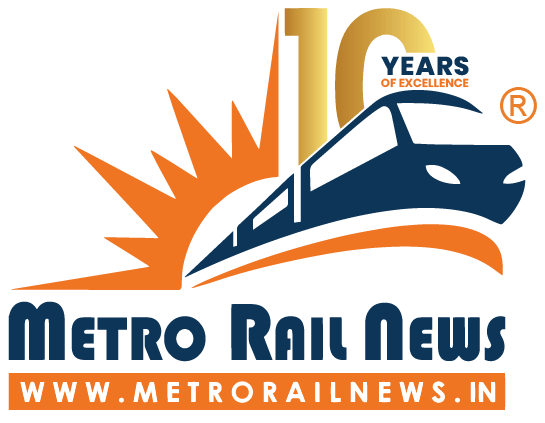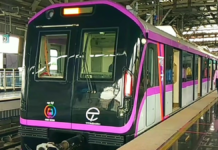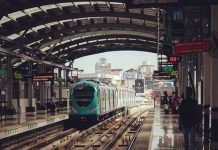Metro Rail News conducted an in-person interview with Mr. Ravindra Kumar Jain, Managing Director, Dedicated Freight Corridor Corporation of India (DFCCIL). In the interview, Mr. Jain talked about Dedicated Freight Corridors and his experiences.
Mr. Ravindra Kumar Jain, IRSE, assumed the charge of Managing Director of Dedicated Freight Corridor Corporation of India Limited on 11.12.2020. He is an officer of ‘Indian Railway Service of Engineers’ (IRSE) of 1986 batch. He completed his B.Tech. in Civil Engineering from MNIT, Jaipur and M.Tech. in Environmental Engineering from the University of Roorkee (now IIT, Roorkee). Before joining DFCCIL, he was posted as Chief Administrative Officer/Construction for Eastern Railway, Kolkata. Prior to that, he worked as Executive Director, Civil Engineering/Plg, Railway Board.
From 2017 to 2019, he was Divisional Railway manager, Samastipur (ECR). His tenure is remembered for Mithila painting at Madhubani station and then on the rake of Bihar Sampark Kranti. For this, his team was honoured by Hon’ble Minister Railway and later also by Chairman, Railway Board. He was also adjudged as Outstanding DRM in 2018 for manning large nos. of unmanned LCs is a very short time bound schedule.
Here are the edited excerpts: –
How important is DFC for the Railways and the country? What is the present status of the corridors? When is the entire project expected to be commissioned to the nation?
DFCs are going to be a big game changer for the freight operations in India. Basically we are going to say they are going to be revolutionary trends for freight operations. For example, one goods train which starts from JNPT Mumbai takes around 2-3 days to reach NCR because the average speed is just 20-25 kmph. Once the DFC comes into position it will change the scenario entirely as it will reduce the duration from 3 days to 24 hours and the operations of freight trains will be at par with any super fast trains or Rajdhani express. Basically DFC is the first of its kind since independence as it is a rail infrastructure project ever taken under the Ministry of Railways.
Railways are the most energy efficient mode of transport and any growing economy such as India will need infrastructure for transportation as it is the basic backbone of the economy therefore it needs to improve and for that the most sustainable method is railway transportation. With electrification and other innovations we are almost going to achieve a zero emission stage so obviously for any country to achieve sustainable and green development, India is giving a good solution in the form of DFC. The DFC project planning and ideas started in 2006-2007 and the concept plan took shape in 2008 along with the detailed estimates.
The actual work started in 2014 when the land acquisition was also in position and right now we are working on 2 DFCs, the first one is the eastern corridor starting from Ludhiana via Dadri, Khurja to Dankuni in West Bengal and it is about 1,875 kms long and the other corridor is the western corridor that starts from Mumbai, JNPT and ends up in Dardri that is in UP and it is about 1506 kms and altogether it is around 3374 km long and out of that we are currently working on 2850 km. Regarding the current status, in the last one year we have commissioned around 1347 km, which is almost 47%.
Please share the details of the scale up plan of the DFCs, if any. How is the proposed DFC expected to look alike in its subsequent stages if any plan envisaged. What shall be the major impacts and benefits?
For DFC we are working very vigorously and persistently. We are intending to complete 90% of work within a year that is June 2023 and then some small work on western corridor pertaining to Maharashtra may lag behind otherwise we will be completing most of the work in a year. The DFC will bring reduction in the logistics costs as our honorable PM and Railway Minister also have the aim to reduce the logistics costs and to achieve that firstly we should have an efficient transportation system and secondly the turn around should also be better.
So the DFC trains will be faster, heavier, longer and higher than the existing trains. The DFC has got the latest technology, latest specifications and much better type of operation which will give reliable and scheduled operations. We will provide IT enabling systems to the customers so that they can track the trains. We are providing IT and customer friendly services and reliability of services which will change the entire scenario of the freight systems in the country.
We will work for the bulk product as well as non bulk products, e-commerce, parcels, perishables and any other items that you can think of and obviously highest priority will be import and export through containers. To provide impact to the economy, along with the DFC the government has already planned multi modal logistic parks and these parks will have integration with other modes of transportations that will provide first and last mile connectivity. This is going to make India a competitive market and our products will comparatively be a bit cheaper as compared to today’s rates and it is therefore going to make a huge difference.
Do you think a dedicated track for freight transportation in the country should have been introduced much earlier? Why do you think there has been a delay on this front by railways for so many years?
I beg to differ from you as there has not been a delay. At the time of independence the railways used to carry around 80% of the goods but after the road transportation it has been reduced to 25% so our modal share has reduced but the volume has increased. So the reason why we were not able to compete with the road transport is because we have a mix traffic of operations as we have both passenger and goods train on the same tracks and the passenger should always be a priority that is why the goods operation gets less priority and the average speed goes down and the therefore the reliability of services goes down.
Secondly, we tried through the doubling, the tunnelling, improving the junction arrangement and made changes such as electrification and much more for improvement which needs investment but the investment in road transport is much higher. So after experimenting with many different ideas we decided that now is the time to take a different step and that was DFC. So it is never late or never early but these decisions are taken on the basis of economic growth of the country and the need of the hour. So in 2006 we thought that now is the time to go for DFC but it has many challenges such as land acquisition and finances and therefore these decisions have to be taken after so much planning.
DFCCIL is a Public Sector Undertaking (PSU) corporation registered as a company under the companies act. In what ways the formation of the PSU is helping in execution of the project. What additional leverage DFCCIL requires for a timely completion of the project?
Firstly DFC is a PSU and registered under the Ministry of Railways and we are linked with the Ministry of Railways through an agreement for the next 30 years. While working as a PSU we are exclusively working on the DFC and we have no other projects but we have 4-5 major activities related to the DFCs that are to construct and commission, to operate and maintain the corridors, to develop business for moving on this corridor and to think and plan about the future development of this corridor. We have got leverage because a government department has to work in different ways and there are so many rules and regulations and theoretically it takes extra time whereas in DFC PSU we work in a very straightforward manner and that is why we are able to implement it much faster. DFC will provide operation and maintenance at much lower cost than any other transportation including that of Indian Railways. Our systems will be modern and IT enabled which can track the trains and modern systems such as OHE and Signalling are used. Even our maintenance will be done with modern equipment and gadgets as they will be monitored on a real time basis and GPS systems will be used for tracking so it will be very cost effective.
Your pioneering and memorable initiative in aesthetically depicting Mithila painting at the entire Madhubani Station and Rake of Bihar Sampark Kranti being DRM Samastipur is still widely appreciated. Would you like to share some of your views regarding the initiative you took in a creative manner?
I feel very nostalgic remembering that. Actually I joined at the end of April 2017 in Samastipur division where the Madhubani Station lies. After a few months of working there I got a complete list of cleanliness ranking of around 470 stations and It included a list of A and B class railway stations of Indian railways. In that list Madhubani station was almost at the end on 369 number and when I saw that I felt very bad and at that time my knowledge regarding the Madhubani and Mithila painting was not at par so I enquired that the area is so rich in culture and have such a beautiful history and heritage. I thought about why this station is so poorly kept and then surveyed the station along with my team and decided to change the look of the whole station.
I instructed for the walls to be painted fully white and then called all the local artists and said that we will provide you the space, paints and all that you need and you can do the Mithila painting on these walls. On 2nd October, 2017 we started this cleanliness drive and around 30 people including children came and in a week their numbers crossed hundred so the entire station was taken over by the locals and everybody was keen to do their own paintings and the result was so beautiful as if it was a museum. Nobody thought in the beginning that we were making history. When the next ranking list came, Madhubani Station was in the top 3. It was also appreciated by the Railways Minister and even an award was sanctioned for the station.
Same thing happened with the Bihar Sampark Kranti as on that particular rake I personally requested the General Manager Shri L.C. Trivedi to permit us to paint the express which starts from Darbhanga and goes to Delhi and he also took the permission from the ministers and after we got the permission we asked the local painters to please come again and paint the coaches and it was so beautifully done that from whichever station the train passed people gathered to take a look and it even got famous on social media even outside India.
We also permitted the painters to write their names along with their mobile numbers on the paintings. Through the social media clips so many agencies in India as well as outside the country contacted those painters and gave them orders for the paintings in their areas. Then after that the Mithila painting came to Delhi and in Patna also and various parts of the country.
With an experience of various key positions in civil engineering departments and in other administrative assignments in various zones of Indian railway what has been your best experience for the job and responsibilities held? Which significant accomplishment you would like to mention and recall.
Again you have made me nostalgic. The thing I remember the most is my tenure for 2 years as DRM of Samastipur and not just because of the Madhubani painting on the station and the rake but because we tried to provide the best possible help to employees . One such case is that one of our keyman was run over by a train and you won’t believe that on the very next day his widow was given the PPO that is the pension order and after that the very next day we gave her the appointment. I really feel that we were in a position that we were able to provide help to the family who was in shock with their only earning member dying. On the safety front we did the mining of more than 300 crossings in a record time of 3-4 months and for that the division got a special award from the chairman of the Railway Board.
Beyond this particular tenure I still remember my tenure as Deputy Chief Engineer, Jaipur where I was fully involved for the first time in the gauge conversion of the Jaipur station itself. That time was in 1992-94 where it was only a meter gauge station and I was incharge when the broad gauge was introduced for the first time in the station and that was a historical moment. Then my posting in Ahmedabad was very wonderful where I did more than 1000 km of gauge conversion including Bhavnagar, Palampur etc. and lastly my tenure in Mumbai where we were maintaining all the suburban stations, suburban quarters and so many other things. The life and working is entirely different in Mumbai as we worked on the suburban stations day and night and it was very challenging. These are the reasons which give me strength to continue hard work and sincere work that have led me to this position.
With the present policies of the govt. for the railways how do you see IR in the coming few years? Is there any sector IR that needs immediate attention being overlooked?
Indian railways has got a very bright future as it is the lifeline of the country and the nation depends on it so we have to strengthen the railways. Whosoever wants to join the Railways I wholeheartedly welcome them. In Railways the hardwork and sincerity is very essential as this sector is very challenging and every railway personnel works very seriously that is when they are given any assignment they do that with so much devotion. It is the reason why Railways are running 24/7 in all parts of the country. So I want to say that whoever is interested in joining Railways is going to have a bright time as the railways are here forever and the country needs it and its services. That is why it is said that after the army it is the railways in the hierarchy.
Being a stellar technocrat with experience of multiple positions, what would be your message to young minds willing to join railways? Kindly share your views about Metro Rail News. Any message to our readers?
I want to convey my message to all the youngsters that if they want to innovate the country needs them. Every youngster should think of new technologies, developments and new innovation for doing anything faster and much more efficiently with low costs. Our country is going to become a 5 trillion economy very soon and by 2050 it may be ten times of that. So we need young and innovative minds to achieve these targets. It is very tough but we need to be among the world’s top 3 economies in time to come. In Railways we have had so much change especially in the last 5-10 years that things have changed entirely. Otherwise we were just working on normal stations and normal trains but soon we will have zero waitings lists. The DFC, high speed rails and metros and other projects and new technologies will be achieved with new ideas and innovations. For any country, continuous growth and sustainable development is very important and railways provide that type of transportation.
Thank you to Metro Rail News for inviting me and giving me the opportunity to express myself. My message to the readers of MRN is that we need to contribute to the development of the country. Wherever the infra projects are happening we should provide them all the possible support. Sometimes we have seen that the locals come in the way of ongoing projects which are being carried out. The people should think that they are a part of the nation’s development. Our country requires growth and development and young innovative minds can provide that.






